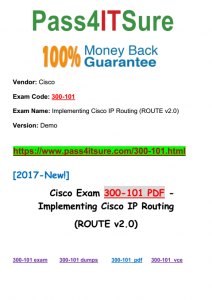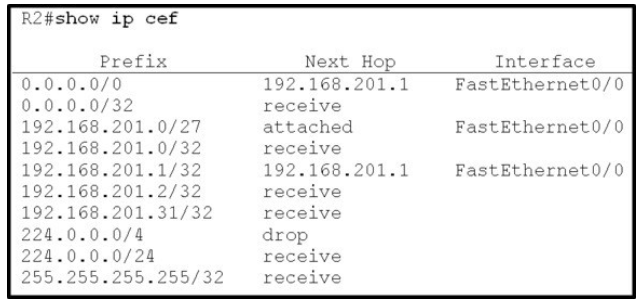Where can I get the valid Cisco 300-101 dumps exam questions for passing? “Implementing Cisco IP Routing (ROUTE v2.0)” is the name of Cisco 300-101 exam dumps which covers all the knowledge points of the real Cisco exam. Latest Cisco ROUTE 300-101 dumps pdf actual test free download. Pass4itsure 300-101 dumps exam questions answers are updated (476 Q&As) are verified by experts. The associated certifications of 300-101 dumps is CCDP. The Pass4itsure practice exam software offers you a real exam simulation for https://www.pass4itsure.com/300-101.html dumps Implementing Cisco IP Routing (ROUTE v2.0) exam.
Exam Code: 300-101
Exam Name: Implementing Cisco IP Routing (ROUTE v2.0)
Updated: Sep 04, 2017
Q&As: 476
[Updated September 2017 Cisco 300-101 Dumps From Google Drive]: https://drive.google.com/open?id=0BwxjZr-ZDwwWWDdYaFM0SVFwMTA
[Updated September 2017 Cisco 300-165 Dumps From Google Drive]: https://drive.google.com/open?id=0BwxjZr-ZDwwWeTBEWVNsUmFmOEU
The interface of practice exam is user-friendly, once you try the demo, you will get acquainted with the 300-101 dumps software interface.

Question Set 1
QUESTION 1
Refer to the exhibit.

Based on this FIB table, which statement is correct?
A. There is no default gateway.
B. The IP address of the router on FastEthernet is 209.168.201.1.
C. The gateway of last resort is 192.168.201.1.
D. The router will listen for all multicast traffic.
300-101 exam Correct Answer: C
Explanation
Explanation/Reference:
Explanation:
The 0.0.0.0/0 route is the default route and is listed as the first CEF entry. Here we see the next hop for this default route lists 192.168.201.1 as the default router
(gateway of last resort).
QUESTION 2
Refer to the exhibit.

A network administrator checks this adjacency table on a router. What is a possible cause for the incomplete marking?
A. incomplete ARP information
B. incorrect ACL
C. dynamic routing protocol failure
D. serial link congestion
Correct Answer: A
Explanation
Explanation/Reference:
Explanation:
To display information about the Cisco Express Forwarding adjacency table or the hardware Layer 3-switching adjacency table, use the show adjacency
command.
Reasons for Incomplete Adjacencies
There are two known reasons for an incomplete adjacency:
The router cannot use ARP successfully for the next-hop interface.
After a clear ip arp or a clear adjacency command, the router marks the adjacency as incomplete. Then it fails to clear the entry.
In an MPLS environment, IP CEF should be enabeled for Label Switching. Interface level command ip route-cache cef
No ARP Entry
When CEF cannot locate a valid adjacency for a destination prefix, it punts the packets to the CPU for ARP resolution and, in turn, for completion of the adjacency.
QUESTION 3
A network engineer notices that transmission rates of senders of TCP traffic sharply increase and decrease simultaneously during periods of congestion. Which 300-101 dumps condition causes this?
A. global synchronization
B. tail drop
C. random early detection
D. queue management algorithm
Correct Answer: A
Explanation
Explanation/Reference: Explanation:
TCP global synchronization in computer networks can happen to TCP/IP flows during periods of congestion because each sender will reduce their transmission
rate at the same time when packet loss occurs.
Routers on the Internet normally have packet queues, to allow them to hold packets when the network is busy, rather than discarding them.
Because routers have limited resources, the size of these queues is also limited. The simplest technique to limit queue size is known as tail drop. The queue is
allowed to fill to its maximum size, and then any new packets are simply discarded, until there is space in the queue again. This causes problems when used on
TCP/IP routers handling multiple TCP streams, especially when bursty traffic is present. While the network is stable, the queue is constantly full, and there are no
problems except that the full queue results in high latency. However, the introduction of a sudden burst of traffic may cause large numbers of established, steady
streams to lose packets simultaneously.
QUESTION 4
Which three problems result from application mixing of UDP and TCP streams within a network with no QoS? (Choose three.)
A. starvation
B. jitter
C. latency
D. windowing
E. lower throughput
Correct Answer: ACE
Explanation
Explanation/Reference:
Explanation:
It is a general best practice not to mix TCP-based traffic with UDP-based traffic (especially streaming video) within a single service provider class due to the behaviors of these protocols during periods of congestion. Specifically, TCP transmitters will throttle-back flows when drops have been detected. Although some
UDP applications have application-level windowing, 300-101 pdf flow control, and retransmission capabilities, most UDP transmitters are completely oblivious to drops and thus never lower transmission rates due to dropping. When TCP flows are combined with UDP flows in a single service provider class and the class experiences congestion, then TCP flows will continually lower their rates, potentially giving up their bandwidth to drop-oblivious UDP flows. This effect is called TCP-starvation UDP-dominance. This can increase latency and lower the overall throughput. TCP-starvation/UDP-dominance likely occurs if (TCP-based) mission-critical data is assigned to the same service provider class as (UDP-based) streaming video and the class experiences sustained congestion. Even if WRED is enabled on the service provider class, the same behavior would be observed, as WRED (for the most part) only affects TCP-based flows. Granted, it is not always possible to separate TCP-based flows from UDP-based flows, but it is beneficial to be aware of this behavior when making such application-mixing decisions. Reference:
QUESTION 5.The format of an IP address is w.x.y.z. What does each letter represent?
A.a decimal number from 1 to 64
B.a decimal number from 1 to 32
C.a decimal number from 1 to 16
D.a decimal number from 1 to 254
E.None of the above
300-101 vce Correct:D
QUESTION 6.Which of the following is TRUE about the Linux kernel? (Select the best answer.)
A.The kernel allows the user to directly interact with the hardware registers.
B.The kernel allows dynamic loading and unloading of device drivers.
C.The kernel is a software package that includes the shell.
D.The kernel is stored in the MBR.
Correct:B
QUESTION 7.When an environmental event occurs, the current program is suspended and an Interrupt
Service Request is entered. Before this, the state of the current program is saved so that the CPU
can return to it.
A.True
B.False
300-101 exam Correct:
QUESTION 8.Which of the following is/are TRUE about I/O addresses?
A.I/O addresses identify the shared memory between two devices.
B.I/O addresses assist in passing data back and forth once the device has been identified by the IRQ.
C.Devices can share I/O addresses.
D.None of the above.
E.Both B and C
Correct:B
QUESTION 9
What is an element in UML 2.0?
A. member of a set
B. instance of a class
C. constituent of a model
D. abstract metaclass with only one superclass
E. substance not separable by ordinary chemical means
300-101 dumps Correct Answer: C
QUESTION 10
What is a relationship in UML 2.0?
A. the state of being related
B. an element that has no derived union
C. an element that has no derived composition
D. an element that must have two owned elements
E. an element that specifies a connection between elements
Correct Answer: E
QUESTION 11
What is true about a comment in UML 2.0? (Choose two)
A. is shown as a note symbol
B. must be attached to at most one element
C. contains only machine-readable symbols
D. can be attached to more than one element
E. connections are always shown with a dashed line
300-101 pdf Correct Answer: AD
QUESTION 12
What is true about every named element that is a member of a namespace?
A. It is owned by the namespace.
B. It has one unique name within the namespace.
C. It is identified by its name within the namespace.
D. It can be distinguished from other members in the namespace.
Correct Answer: D
QUESTION 13
What is true of the import example in the exhibit?
A. Webshop is imported into ShoppingCart and then further imported into Auxiliary and Types.
B. Auxiliary and Types are imported into ShoppingCart, but neither can be further imported into WebShop.
C. Public members of WebShop are imported into ShoppingCart and then further imported into Auxiliary or
Types.
D. Public members of Types and Auxiliary are imported into ShoppingCart and then further imported into
WebShop.
E. Public members of Types and Auxiliary are imported into ShoppingCart and those from Types are
further imported into WebShop.
300-101 vce Correct Answer: E
QUESTION 14
What does an {ordered} designator do for a multiplicity?
A. specifies that values are sequentially ordered
B. specifies an inclusive interval of non-negative integers
C. indicates the correct sequence of messages in a sequence diagram
D. indicates that the upper bound must be greater than the lower bound for the multiplicity
Correct Answer: A
QUESTION 15
What is an expression in UML 2.0?
A. comment placed on a diagram
B. symbol or symbols signifying a set of value
C. graphical addition to a diagramming element
D. language-specific string used to describe the meaning of a diagram
E. language-specific text string used to describe the contents of a diagram
300-101 exam Correct Answer: B
QUESTION 16
Constraints are shown using what symbols?
A. [ ]
B. ( )
C. { }
D. ?”
E. ” ”
Correct Answer: C
The practice exam comes with the features, which enables you to pass Cisco 300-101 dumps exam with good grades. Also, the practice exam for Implementing Cisco IP Routing (ROUTE v2.0) helps you to prepare for the actual https://www.pass4itsure.com/300-101.html dumps exam with its timed exam feature.